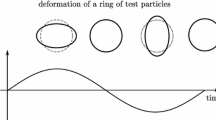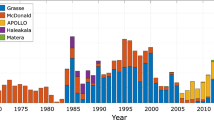Abstract
Frequency-domain multiplexing has been used for reading out ∼1000 detectors on the APEX-SZ and South Pole Telescope receiver for half a decade and produced many high-impact science papers. A new digital FPGA-based backend reduces the power consumption and system-size by an order of magnitude. This Digital Frequency-domain Multiplexer (DfMUX) was operated successfully in a space-like environment during the stratospheric balloon test-flight of the EBEX polarimeter, saw first light on the POLARBEAR experiment in 2010, and will be deployed for the South Pole Telescope polarimeter and ASTE sub-mm continuum camera. We are presently developing a new generation DfMUX targeting a factor 5 lower power consumption and robustness for satellite platforms. The system will incorporate new technology for identifying and correcting radiation induced errors in the FPGA logic, higher bandwidth to accommodate a multiplexing factor of 64, and Digital Active Nulling (DAN) feedback. DAN linearizes the SQUID system response while dramatically reducing its input impedance.


Similar content being viewed by others
References
J. Bock et al. (2009). arXiv:0906.1188 [astro-ph.CO]
The COrE Collaboration (2011). arXiv:1102.2181 [astro-ph.CO]
P. Mauskopf et al., SPIE Conf. Ser. 7020, 70200N (2008). doi:10.1117/12.788976
J. Bock et al., Astro2010: The Astronomy and Astrophysics Decadal Survey 2010, 45 (2009)
K.D. Irwin, Physica C 368, 203–210 (2002)
T.M. Lanting et al., Appl. Phys. Lett. 86, 112511 (2005)
M. Dobbs, et al., Frequency multiplexed SQUID readout of large bolometer arrays for cosmic microwave background measurements, submitted to Rev. Sci. Instrum. Dec 2011. arXiv:1112.4215 [astro-ph.IM]
M. Dobbs, E. Bissonnette, H. Spieler, IEEE Trans. Nucl. Sci. 55, 21–26 (2008). arXiv:0708.2762
K. MacDermid et al., AIP Conf. Ser. 1185, 253–256 (2009). arXiv:0911.4448
G. Smecher, F. Aubin, E. Bissonnette, M. Dobbs, P. Hyland, K. MacDermid, IEEE Trans. Instr. & Meas. 61, 251–260 (2012). http://ieeexplore.ieee.orgxpl/freeabs_all.jsp?arnumber=5978802. doi:10.1109/TIM.2011.2161012
G. Smecher et al., SPIE Conf. Ser. 7741, 77412U (2010)
F. Aubin et al., SPIE Conf. Ser. 7741, 77411T (2010)
K. Arnold et al., SPIE Conf. Ser. 7741, 77411E (2010)
J. McMahon et al., AIP Conf. Ser. 1185, 511 (2009)
H. Spieler, in Monterey Far-IR, Sub-mm and mm Detector Technology Proceedings, pp. 243–249 (2002)
R. den Hartog et al., IEEE Trans. Appl. Supercond. PP 99, 1–5 (2011)
A. Bounab et al., EAS 37, 101–106 (2009)
Y. Takei, N.Y. Yamasaki, W. Hirakoso, S. Kimura, K. Mitsuda, Supercond. Sci. Technol. 22, 114008 (2009)
T. de Haan et al., Digital feedback for frequency multiplexed TES readout, in preparation
Acknowledgements
The McGill authors acknowledge funding from the Canadian Space Agency, Natural Sciences and Engineering Research Council, Canadian Institute for Advanced Research, and Canadian Foundation for Innovation. M.D. acknowledges support from an Alfred P. Sloan Research Fellowship and Canada Research Chairs program. The South Pole Telescope is a National Science Foundation funded project through grants ANT-0638937 and ANT-0130612. EBEX is a NASA supported mission through grant numbers NNX08AG40G and NNX07AP36H. The Polarbear project is funded by the National Science Foundation under grant AST-0618398.
Author information
Authors and Affiliations
Corresponding author
Rights and permissions
About this article
Cite this article
Dobbs, M., Aubin, F., de Haan, T. et al. Digital Frequency Multiplexer for TES Detectors—Path to Flight. J Low Temp Phys 167, 568–574 (2012). https://doi.org/10.1007/s10909-012-0470-5
Received:
Accepted:
Published:
Issue Date:
DOI: https://doi.org/10.1007/s10909-012-0470-5




